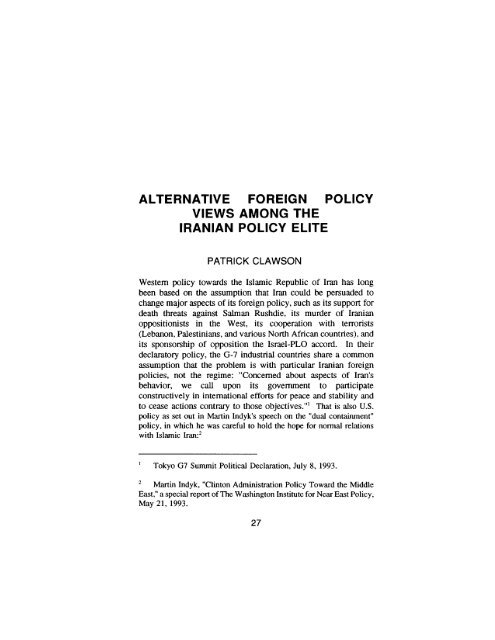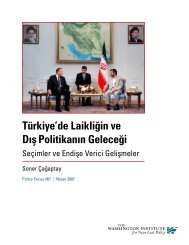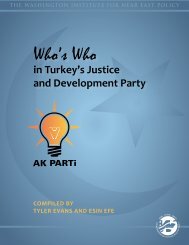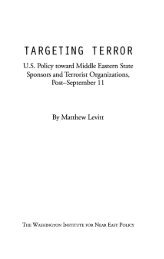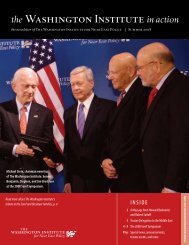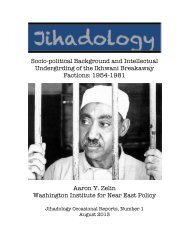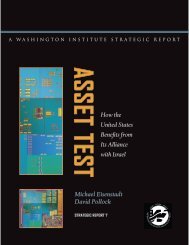alternative foreign policy views among the iranian policy elite
alternative foreign policy views among the iranian policy elite
alternative foreign policy views among the iranian policy elite
You also want an ePaper? Increase the reach of your titles
YUMPU automatically turns print PDFs into web optimized ePapers that Google loves.
A L T E R N A T I V E FOREIGN POLICYVIEWS AMONG THEIRANIAN POLICY ELITEPATRICK CLAWSONWestem <strong>policy</strong> towards <strong>the</strong> Islamic Republic of Ivan has longbeen based on <strong>the</strong> assumption that Iran could be persuaded tochange major aspects of its <strong>foreign</strong> <strong>policy</strong>, such as its support fordeath threats against Salman Rushdie, its murder of Iranianoppositionists in <strong>the</strong> West, its cooperation with terrorists(Lebanon, Palestinians, and various North African countries), andits sponsorship of opposition <strong>the</strong> lsrael-PLO accord. In <strong>the</strong>irdeclaratory <strong>policy</strong>, <strong>the</strong> G-7 industrial countries share a commonassumption that <strong>the</strong> problem is with particular Iranian <strong>foreign</strong>policies, not <strong>the</strong> regime: "Concemed about aspects of Iran'sbehavior, we call upon its govemment to participateconstructively in intemational efforts for peace and stability andto cease actions contrary to those objectives. ''1 That is also U.S.<strong>policy</strong> as set out in Martin Indyk's speech on <strong>the</strong> "dual contaimnent"<strong>policy</strong>, in which he was careful to hold <strong>the</strong> hope for normal relationswith Islamic Iran: 2i Tokyo G7 Summit Political Declaration, July 8, 1993.2 Martin Indyk, "Clinton Administration Policy Toward <strong>the</strong> MiddleEast," a special report of The Washington Institute for Near East Policy,May 21, 1993.27
28 IRAN'S STRATEGIC INTENTIONSI should emphasize that <strong>the</strong> Clinton administration is notopposed to Islamic government in Iran. Indeed, we haveexcellent relations with a number of Islamic governments.Ra<strong>the</strong>r, we are firmly opposed to <strong>the</strong>se specific aspects of <strong>the</strong>Iranian regime's behavior, as well as its abuse of <strong>the</strong> humanrights of <strong>the</strong> Iranian people. We do not seek a confrontation,but we will not normalize relations with Iran until and unlessIran's policies change, across <strong>the</strong> board.There are some contrary voices, who suggest that Iranianbehavior is not likely to change. Their argument is madestronger by <strong>the</strong> frequent dashing of hopes that moderates wouldconsolidate power and change <strong>policy</strong>--a hope first held out inDecember 1979 when <strong>the</strong> election of Bani Sadr as president wassaid to foreshadow release of <strong>the</strong> American embassy hostages,and <strong>the</strong>n repeated regularly with each twist and tum of Iranianpolitics. Talk of Iranian moderates has been unpopular <strong>among</strong>U.S. politicians since <strong>the</strong> days of <strong>the</strong> Iran-Contra affair, in whichPresident Reagan was so badly bumed (<strong>the</strong> release of some U.S.hostages being matched by <strong>the</strong> taking of new ones). SomeEuropeans also express in private <strong>the</strong>ir doubts about Iranianmoderation. In a meeting with U.S. Secretary of State WarrenChristopher, Foreign Minister Claes of Belgium (which <strong>the</strong>n held<strong>the</strong> EC Presidency) was quoted by U.S. officials as saying, "Itwould be a historic mistake" for Europeans to believe <strong>the</strong>y couldcontinue <strong>the</strong> search for Iranian moderates. 3How realistic is <strong>the</strong> assumption that <strong>the</strong> Islamic Republiccould be persuaded to change important aspects of its <strong>foreign</strong><strong>policy</strong>? Surely <strong>the</strong> answer to that question depends not onlyupon what <strong>the</strong> West does, but also upon <strong>the</strong> factors inside Iranthat shape <strong>foreign</strong> l~licy. The aim of this paper is to examineone of <strong>the</strong> most important such factors, namely, <strong>the</strong> attitudes3 New York Times, December 2, 1993.28
PATRICK CLAWSON 29towards <strong>foreign</strong> <strong>policy</strong>.THE SIGNIFICANCE OFFOREIGN POLICYAs in most countries, <strong>foreign</strong> <strong>policy</strong> is less important thandomestic politics to Iranians and Iranian politicians. Forexample, <strong>the</strong> headline in <strong>the</strong> January 25, 1994 Keyhan (<strong>the</strong>country's leading paper) read "Joint Govemment, Majlis Meetingto Examine Country's Most Important Issues"--and <strong>foreign</strong><strong>policy</strong> was not mentioned at all <strong>among</strong> <strong>the</strong> many issues.Whe<strong>the</strong>r ideologues or pragmatists, members of <strong>the</strong> Iranian <strong>elite</strong>have a whole host of domestic matters to occupy <strong>the</strong>ir time andattention. Foreign <strong>policy</strong> is subordinate to <strong>the</strong>se pressingdomestic issues--subordinate in <strong>the</strong> dual sense that <strong>foreign</strong> <strong>policy</strong>comes second and also that <strong>foreign</strong> <strong>policy</strong> is seen through <strong>the</strong>lens of how it affects domestic <strong>policy</strong>.The Iranian political classes have lots of domestic problemson <strong>the</strong>ir mind <strong>the</strong>se days. Let me cite just two <strong>among</strong> <strong>the</strong> manydomestic issues which preoccupy <strong>the</strong>m but which have receivedrelatively little coverage in <strong>the</strong> Westem media. First is <strong>the</strong>supreme religious leadership. The generation of pre-revolutionGrand Ayatollahs has largely passed from <strong>the</strong> scene, with <strong>the</strong>1992 death of <strong>the</strong> widely respected Khoei of Iraq and <strong>the</strong> 1993death of <strong>the</strong> Iranian Golyepagani. The problem for <strong>the</strong> IslamicRepublic is that its principal political-religious figures are not<strong>among</strong> those who can claim to have eamed <strong>the</strong> title of GrandAyatollah since <strong>the</strong> revolution. The country's officiallydesignated political religious guide, Khamenei, desperately soughtacceptance as Khoei's successor in <strong>the</strong> role of "source ofimitation" (supreme living religious guide), but his claim was metwith resistance if not ridicule. 4 Nor are <strong>the</strong> prayer leaders in <strong>the</strong>main cities or o<strong>the</strong>r religious leaders closely identified with <strong>the</strong>4 Mideast Monitor, February 26, 1993, quoting from al-Majalla.
30 IRAN'S STRATEGIC INTENTIONSregime regarded as plausible "sources of imitation. ''5 This ismore than a source of embarrassment, it is a serious politicalproblem. The regime is not seen by <strong>the</strong> people or by <strong>the</strong>religious establishment as being <strong>the</strong> embodiment of religiousvalues, which challenges its entire self-conception. Plus <strong>the</strong>re is<strong>the</strong> practical problem that no prominent leader appears to beinterested in <strong>the</strong> job now held by Khamenei. Were he to die, <strong>the</strong>job would have to be filled by some second-ranker, which wouldfur<strong>the</strong>r undermine <strong>the</strong> regime's claims to religious privilege.A second domestic issue that absorbs <strong>the</strong> political leadershipis <strong>the</strong> self-perceived unpopularity of <strong>the</strong> present system. During<strong>the</strong> first decade after <strong>the</strong> 1979 revolution, Islamic Iran's leaderstook great pride in <strong>the</strong> hundreds of thousands of people whowould regularly turn out to demonstrate <strong>the</strong>ir commitment to <strong>the</strong>revolution's value. The leaders now feel that <strong>the</strong> population isnot necessarily on <strong>the</strong>ir side. Listen to <strong>the</strong> leaders' words:Khamenei, speaking on "Revolutionary Guards Day" to a groupof Guards, said, 6Don't think that <strong>the</strong> Islamic Republic is going to be destroyedby <strong>the</strong> utterances of a few simple-minded wishful thinkers whosay it is going to end today or tomorrow . . . . [But] Iran isalone in <strong>the</strong> world today . . . . The element of loneliness in <strong>the</strong>contemporary movement has created a degree of similaritybetween us and <strong>the</strong> movement of Husayn Bin-Ali [who wasslaughtered with all his followers in a battle he enteredknowing <strong>the</strong> outcome would be certain death].The regime has gone so far as to hold exercises with 122,000Bassidj-force reservists in 170 cities, practicing seizing public5 The regime is reduced to promoting <strong>the</strong> qualifications of aheretofore obscure centelmrian, Ayatolhth Araki; cf. Jomhuri Islami,December 21 ,and 22, 1993, as printed in Akhbaar.6 Radio Tehran, ,as transcribed in FBIS, January 18, 1994.
PATRICK CLAWSON 31buildings and radio stations from rioters, including an exercisethat closed a section of downtown Tehran while troops"recaptured" <strong>the</strong> Majlis. 7 The outbreak of riots in several majorcities in spring and summer 1992 has left <strong>the</strong> regime nervous,partly because popular demonstrations of unrest continueregularly. For instance, in a January 1994 riot, "a large number[of] troublemakers" used cranes to haul concrete blocks onto ahighway in sou<strong>the</strong>ast Tehran. 8Foreign <strong>policy</strong> is seen through <strong>the</strong> prism of domestic issueslike <strong>the</strong>se. So, for instance, <strong>the</strong> Islamic Republic ishypersensitive to <strong>the</strong> attitude of <strong>foreign</strong> governments to <strong>the</strong>members of <strong>the</strong> People's Mojahedeen, because Tehran is worriedabout popular unrest. However unreal may be <strong>the</strong>reconcerns--and I very much doubt that <strong>the</strong> Mojahedeen couldorganize unrest, much less seriously challenge <strong>the</strong> regime--Iran'sleaders regard any toleration for activities of <strong>the</strong> Mojahedeen asevidence of <strong>foreign</strong> plotting against <strong>the</strong>ir govemment.The primacy of domestic politics, and <strong>the</strong> viewing of <strong>foreign</strong><strong>policy</strong> through <strong>the</strong> lens of domestic issues, applies also to <strong>the</strong>famous split between radicals and moderates. Despite <strong>the</strong>repeated denials by <strong>the</strong> regime's voices in <strong>the</strong> West, Iranians viewpolitics since 1981 as characterized by a split between radicalsand moderates. The differences between <strong>the</strong> two are primarilyabout domestic <strong>policy</strong>, as was nicely stated July 28, 1993 bySalaam, a newspaper close to <strong>the</strong> radicals:Everybody knows that <strong>the</strong>re have been two major trendsof thought in our society since <strong>the</strong> revolution . . . . Onetendency believed "social justice" to be <strong>the</strong> central <strong>the</strong>me of<strong>the</strong> economy and regarded <strong>the</strong> fundamental duty of <strong>the</strong> Islamicgovernment ,as support for <strong>the</strong> deprived and <strong>the</strong> barefoot . . . .7 lran Times, December 3, 1993. The exercise, during Bassidj Week,was code-named KHANDAQ.8 Jomhuri lslami cited in lran Times, January 14, 1994.
32 IRAN'S STRATEGIC INTENTIONSIn <strong>the</strong> <strong>foreign</strong> <strong>policy</strong> arena, it believed in full resistance to <strong>the</strong>West and <strong>the</strong> US, support for Islamic and liberationmovements, and close relations with <strong>the</strong> Third World countries.To sum up, this tendency regarded itself as follower of <strong>the</strong>Imam [Khomeini]'s thoughts and was known as <strong>the</strong> "Imam'sline" tendency in <strong>the</strong> society.The o<strong>the</strong>r tendency emphasized giving a free hand to <strong>the</strong>private sector in <strong>the</strong> economic arena... It regarded any effort tosupport <strong>the</strong> deprived and <strong>the</strong> poor as an influence of Marxistand socialist beliefs. In <strong>the</strong> cultural arena, it believed in acertain dogmatism and backwardness which originated from itstraditio~mlist approach to intellectual developments . . . . In <strong>the</strong><strong>foreign</strong> <strong>policy</strong> arena, it had a cautious approach toward <strong>the</strong>West and <strong>the</strong> US, etc . . . .Since <strong>the</strong> emergence of <strong>the</strong> two tendencies, various titleswere used for <strong>the</strong>m: hardline ,and moderate, radical andconservative, left and right, etc. Both <strong>the</strong> domestic and <strong>foreign</strong>media used <strong>the</strong> various terms . . . .It is true that many people, who believe that "<strong>the</strong> one whowins is right," have change color and have co-ordinated<strong>the</strong>mselves with <strong>the</strong> "tide current." The Majlis member for onetown entered <strong>the</strong> Third [1988] Majlis on behalf of one wing(<strong>the</strong> so-called left wing) and entered <strong>the</strong> Fourth [1992] Majlison behalf of <strong>the</strong> o<strong>the</strong>r wing (<strong>the</strong> so-called right wing).The radical and moderate labels each apply to tendencies, not toformal or tightly knit groups. On any issue, lines may blur, withsome radicals taking a more moderate stance on that point andsome moderates taking a more radical stance. To make aWestem analogy, <strong>the</strong> two trends are more like Democrats andRepublican in <strong>the</strong> U.S. Congress than <strong>the</strong>y are like Labor andConservatives in <strong>the</strong> British Parliament: individual egos, not partydiscipline, rule supreme. To continue <strong>the</strong> analogy, much as <strong>the</strong>Democrats have "old Democrats" and "new Democrats," so <strong>the</strong>moderates are split between technocrats (<strong>the</strong> smaller group, withabout 100 of <strong>the</strong> 270 seats in file Majlis but with domination of<strong>the</strong> ministries) and <strong>the</strong> traditionalists (with about 130 Majlisseats). The traditionalists were well described in <strong>the</strong> New York
PATRICK CLAWSON 33Times as "economically liberal but culturally hard-lineconservatives" connected to <strong>the</strong> bazaar. 9The <strong>the</strong>sis of this paper is that domestic political impulseslead a large majority of Iranian politicians to support two <strong>foreign</strong><strong>policy</strong> stands. The first is an emphasis on economicdevelopment, which is <strong>the</strong> cement that holds toge<strong>the</strong>r <strong>the</strong>moderate coalition of teclmocrats and traditionalists. The <strong>foreign</strong><strong>policy</strong> component of this emphasis on economic development iseconomic ties to <strong>the</strong> West, which is seen as vital by technocratsand enjoys support from <strong>the</strong> traditionalists. The second issue isopposition to Western culture, on which <strong>the</strong> radicals and <strong>the</strong>traditionalists agree. The radicals argue that opposition toWestem culture entails a <strong>foreign</strong> <strong>policy</strong> based on suspicion about<strong>the</strong> West's political agenda and support for anti-Westemmovements, though <strong>the</strong> traditionalists are not so sure if this<strong>foreign</strong> <strong>policy</strong> is necessary. The final section of this paperexamines prospects for <strong>the</strong> future.MODERATES, ECONOMICS,AND THE WESTIranian radicals have generally opposed any emphasis oneconomic growth or on material weUbeing. During <strong>the</strong> 1993election campaign, leading radical Mohtashemi complained,"When you set <strong>the</strong> economy as <strong>the</strong> principle, and sacrificeeverything at its altar, <strong>the</strong>re would remain nothing by which youcould be powerful, free, and independent . . . . We can't haveIslamic and revolutionary culture by slogans and rhetoric whenour economy is a Western capitalist economy. "1° AyatollahKhamenei has shown sympathy for this point of view, though he9 "ban's Chief Faces Merchant Class Challenge," New York Times,January 31, 1993.loS a l a a m , May 17, 1993, as printed in Akhbaar.
34 IRAN'S STRATEGIC INTENTIONShas not been active on <strong>the</strong> issue. ~1 To <strong>the</strong> extent <strong>the</strong>y careabout economics, <strong>the</strong> radicals prefer to emphasize social justiceand state control, not economic growth. The economic policies<strong>the</strong>y implemented when <strong>the</strong>y ran <strong>the</strong> govemment were Indiansocialism, with "economic self-sufficiency, a disdain forconsumerisim, a stress on national planning, <strong>the</strong> tightening of <strong>the</strong>state's clutches on industries, restrictions on <strong>foreign</strong> trade,maintenance of an overvalued currency, and hostility to <strong>foreign</strong>investment. ''12By contrast, Iranian technocrats are very interested ineconomic growth---much more so than in <strong>foreign</strong> <strong>policy</strong>. Forinstance, President Rafsanjani's 1993 election address was 95percent about economics; <strong>foreign</strong> <strong>policy</strong> was barely mentioned. 13In choosing to stake his reputation on economics, Rafsanjani hasmade a dangerous gamble. His problem is that income cannotmatch popular expectations, no matter how good are <strong>the</strong> policies.Expectations formed during <strong>the</strong> oil boom under <strong>the</strong> Shah's ruleare that Iran can have a standard of living similar to that in <strong>the</strong>West, which was <strong>the</strong> goal that <strong>the</strong> Shah held out. That goal wasalways ambitious for this generation, and it became completelyunrealistic after <strong>the</strong> oil crash of 1985. Iran's per capita earningsfrom oil, in real terms, are no more than one-fourth of <strong>the</strong>ir1977/78 level.Rafsanjani recently pointed out that <strong>the</strong> standard of living has" In December 1993 he issued a letter to Rafsanjani that in effectgave him carte blanche to do what he wanted on economic <strong>policy</strong>. Theletter, about <strong>the</strong> Second Five-Year Plan, was issued by <strong>the</strong> IslamicRepublic News Agency on December 20, 1993 (two days beforeRafsanjani presented <strong>the</strong> Plan to <strong>the</strong> Majlis); printed in FBIS, December21, 1993.t2 Jahangir Amuzegar, Iran's Economy under <strong>the</strong> Islamic Republic,London: I.B. Taurus, 1993, p 29713 Tehran TV, May 29, 1993, as transcribed in FBIS-NES.
PATRICK CLAWSON 35improved in <strong>the</strong> last 5 years, during which non-oil GDP grew 7.5percent per annum. TM He could have added that in <strong>the</strong> previousl0 years, basic goods became more widely available, even thoughper capita GDP fell about 50 percentJ 5 Consider <strong>the</strong> followingimprovements:• Infant mortality fell to 35 per 100,000 in 1993/94 from45 in 1989/90 and 100 in 1976J 6 The number of doctorsto 50 per 100,000 in 1993/94 from 34 in 189/90, whichhad also been <strong>the</strong> level in 1976.• The number of higher education students rose to 17 perthousand population in 1993/94 from 8.5 in 1989/90 and4.5 in 1976/77.• The average urban family diet improved in 1990/91compared to <strong>the</strong> pre-revolution level of 1978/79. Inkilograms per annum, consumption of red meat was 148compared to 93 pre-revolution; of butter and shortening,92 compared to 46; of rice, 296 compared to 190; ofbread, 736 compared to 538; of sugar, 170 compared to78.17,4 President Rafsanjani's presentation of <strong>the</strong> second Plan, Tehrantelevision, December 22, 1993, as transcribed in FBIS-NES, December30, 1993.,s Depending upon <strong>the</strong> exact population estimates and <strong>the</strong> technicaldefinition of GDP, <strong>the</strong> estimate reductions cited by Iranians are between50 and 60 percent (Keyhan, February 3, 1991; Keyhan English,February 16, 1991). Central Bank data suggest that 50 percent is aminimum figure.,6 1993/94 and 1989/90 data from President Rafsanjani's presentationof <strong>the</strong> second Plan, Tehran television, December 22, 1993, astranscribed in FBIS-NES, December 30, 1993. 1976 data from BankMarkazi Iran, Annual Report 1356 (1977/78), lor higher educationstudents, and Iran Almanac 1976 (Tehran: Echo of Iran Press, 1976).1~ Keyhan, February 8, 1993, as printed in FBIS.
36 IRAN'S STRATEGIC INTENTIONS• Electricity was found in 99 percent of households in1991; television, 90 percent; refrigerators, 92 percent;washing machines, 34 percent; and automobiles, 14percent--all multiples of <strong>the</strong> 1979 figures. TM Telephonelines rose from 22 per thousand in 1978 to 60 perthousand in 1993.19Despite <strong>the</strong> improvements in <strong>the</strong> standard of living, Iraniansare profoundly pessimistic about <strong>the</strong>ir economic situation. Themood in Tehran about <strong>the</strong> economy is grim, fixated on <strong>the</strong>sharply declining value of <strong>the</strong> rial on <strong>the</strong> free market (from 1450per dollar in late October to 2100 by late December).Rafsanjani's reform program is widely blamed for <strong>the</strong> currenteconomic difficulties. In <strong>the</strong> wake of criticism from Klmmenei<strong>among</strong> o<strong>the</strong>rs, in November he had to reverse price and tradeliberalization 2° while he spent much of December fighting offproposals for postpone <strong>the</strong> Second Five-Year Plan start fromMarch 1994 to March 1995. Meanwhile, <strong>the</strong> <strong>foreign</strong> debtproblems grow worse, forcing cancellation of major, highlyprofitableprojects like <strong>the</strong> $1.7 billion deal to develop <strong>the</strong> SouthPars gas and oil field. 2~ Plus <strong>the</strong> declining price of oil has led<strong>the</strong> Majlis Economic and Finance Committee to propose revising<strong>the</strong> forecast 1994/95 oil revenue to $9.4 billion, compared to18 Iran Statistical Center data printed in Hamshari, January 8, 1994,as translated in Akhbaar; <strong>the</strong> Central Bank data differ slightly.19 President Rafsanjani's presentation of <strong>the</strong> second Plan, Tehrantelevision, December 22, 1993, as transcribed in FBIS-NES, December30, 1993, and Post and Telephone Minister Gharazi, Jomhuri lslami,May 31, 1993.20 Salaam, November 23 and 24, 1993, as printed in Akhbaar. TheCommerce Minister's actions were ~dso described in Hamshari,November 18, 1993, also printed in Akhbaar.21 Resalaat, January 19, 1994, as printed in Akhbaar.
PATRICK CLAWSON 37$18.0 billion in 1990/91. 52 The radical newspaper Salaamgloated in November, 23As long as <strong>the</strong> rival faction was in a majority in <strong>the</strong> Majlis, <strong>the</strong>officials and supporters of <strong>the</strong> adjustment <strong>policy</strong> blamed thatfaction for failure to achieve <strong>the</strong> plan targets . . . . Now that<strong>the</strong>y have lost that pretext and <strong>the</strong> right wing controlseverything, <strong>the</strong>y blame one ano<strong>the</strong>r . . . . The day <strong>the</strong>y tookover <strong>the</strong> government from <strong>the</strong> radicals, <strong>the</strong>y said <strong>the</strong>y hadtaken delivery of an empty treasury . . . . Now it is an honor tohave a country with more than $30 billion debts, with <strong>foreign</strong>companies refusing to sign contracts to sell goods to Iran(owing to Iran's refusal to pay its debts of <strong>the</strong> past three orfour years).It would seem that <strong>the</strong> emphasis on economic growth, <strong>the</strong>importance attributed to access to Western economies, and <strong>the</strong>gloom about economic prospects would all work to increase <strong>the</strong>West's leverage in using economics as a means to change Iranian<strong>foreign</strong> <strong>policy</strong>. But Iranian are convinced that access to Westemeconomies does not require changing political behavior. Iraniansfeel that Europe and Japan will continue trade and investmentirrespective of Iranian actions because of <strong>the</strong> importance of Iranas market and oil supplier. This feeling has some basis in fact.Consider how German govemment spokesmen Dieter Vogelexplained why <strong>the</strong> Iranian Intelligence Minister had been invitedto Bonn on <strong>the</strong> eve of <strong>the</strong> trial of Iranian government agents forfour murders in Berlin by referring to Iran's economicimportance, "We will naturally hold <strong>the</strong> talks with Iran that arerequired by German interests; . . .Iran is a trading partner of22 Resalaat, January 19, 1994, as printed in Akhbaar,.23 S a l a a m , November 22, 1993, as printed in Akhbaar.
38 IRAN'S STRATEGIC INTENTIONSsignificant size. ''24 Or consider that Iran has paid little price forits campaign of assassination of Iranians living in Europe. In areport on several murders in Germany, <strong>the</strong> German FederalCriminal Office concluded, "Behind all <strong>the</strong>se crimes stands asovereign state;... Iran does not shrink from committing seriouscrimes in pursuing its opponents . . . . The reaction in <strong>the</strong> Westis most likely to be verbal" ra<strong>the</strong>r than any action. 25CULTURE, RADICALS, ANDTHE MUSLIM WORLDRadicals place highest priority on combatting Westemism. Anti-Westemism is more than just hooligan squads enforcing properdress by detaining or beating those women judged to be wearing"bad hejab" (visible hair, makeup, and form-fitting clo<strong>the</strong>s).There is also an intellectual element, as seen in conferences likea three-day affair in January 1994. 26 The radical media campaignaround <strong>the</strong> issue regularly, deploring <strong>the</strong> lack of action on"protecting our Islamic-lranian character and identity from <strong>the</strong>cultural conspiracy of those who fear and dislike ourrevolution. ''27The Westemism that <strong>the</strong> radicals confont has many facets.Sexual morality is a vital component: what for <strong>the</strong> West isfreedom for women to participate fully in public life is to Iranianradicals a call for licentious behavior. The use of Westem words24 Vogel,"Allies Oppose Bonn's Iran Links," Washington Post,November 6, 1993.25 Quoted in Rick Atkinson, "Killing of Iranian Dissenters: 'BloodyTrail Back to Tehran'" (a quote from J,'unes O'Dea of AmnestyInternational), Washington Post, November 21, 1993.26 Keyhan International, January 13, 1994.27 Keyhan International, December 23, 1993.
PATRICK CLAWSON 39and Latin letters, from technical literature to popular advertising,is seen as undermining Persian, <strong>the</strong> language of great poets andphilosophers. Television soap operas and rock concertsundermine public plays on religious <strong>the</strong>mes and family outings.Western food displaces a cuisine based on complex saucesprepared in <strong>the</strong> home for large family meals; <strong>the</strong> West evenreplaces traditional Iranian fast food at <strong>the</strong> chelokebab.The radical agenda is not simply medieval obscurantism ornostalgia for small-town and rural life. Much of what ispresented to Iran as Westem culture is in fact decadence thatmany in <strong>the</strong> West also abhor. Iranian radicals reject <strong>the</strong>Madonna of MTV, not <strong>the</strong> Madonna of <strong>the</strong> New Testament.Much of <strong>the</strong> change in Iran's attitude towards <strong>the</strong> West from1964 to 1994 reflects changes in Westem society, not any waveof fundamentalism in Iran. After all, <strong>the</strong> Islamic revulsionagainst <strong>the</strong> West became became a mass movement about adecade after Westem popular culture changed profoundly in waysrepulsive to many, West and East. Sex and violence are staplesof television; story lines reject respect for authority and tradition;individuals are guided by what feels good ra<strong>the</strong>r than by moralvalues of good and evil. Who can be surprised if many Iraniansfind unattractive a society that presents Michael Jackson as oneof its stars?Iran's cultural confrontation with <strong>the</strong> West is not just a moralissue: it is also a matter of <strong>foreign</strong> <strong>policy</strong>, concerning <strong>foreign</strong>govememnts. Leaders across <strong>the</strong> board agree that <strong>the</strong> Westdeliberately uses culture to undermine Iranian society. Forinstance, at <strong>the</strong> ceremony changing leadership of <strong>the</strong> KeyhanInstitute (<strong>the</strong> largest media firm in Iran, owned ex-officio by <strong>the</strong>religious leader), <strong>the</strong> outgoing supervisor Sayed MohammadAshgari condemned "global arrogance's mischevious acts in orderto create division <strong>among</strong> <strong>the</strong> Moslem Iranian people," asserting,"Our revolution is a cultural one based on Islam," while incomingsuperviosr Hossein Shariatmadari said, "Although <strong>the</strong> artillery hasfallen silent, <strong>the</strong> engagement is not over. The only thing is that<strong>the</strong> field of engagement has changed . . . . [Now] <strong>the</strong> war is of
40 IRAN'S STRATEGIC INTENTIONSideas. ''28 Mohammad Javad Larijani, head of <strong>the</strong> MajlisResearch Center, argued that <strong>the</strong> conflict between Western andIslamic culture is not resolvable because "<strong>the</strong> Westerners aredominating <strong>the</strong> Islamic world and want to expand and maintainthat domination. 29While moderates like Larijani sympathize with <strong>the</strong> rejectionof Westemism, on <strong>the</strong> whole <strong>the</strong>y place less emphasis on <strong>the</strong>crusade against Western culture than on <strong>the</strong> need to developeconomically. That causes conflict, because <strong>the</strong> anti-Westemcrusade often clashes with economic liberalization, since <strong>the</strong>former emphasizes respect for tradition while <strong>the</strong> latter permitsindividuals freedom of choice, inlcuding <strong>the</strong> choice to rejecttradition. To take an example that preoccupied Tehran inDecember 1993 and January 1994, <strong>the</strong> liberalization program hasencouraged <strong>foreign</strong> investment and permitted advertising for<strong>foreign</strong> goods--specifically Coca Cola and Westem-stylehamburgers. Revulsion against <strong>the</strong> United States extended so faras to force closure of a restaurant imitating <strong>the</strong> McDonalds styleopened by some Iranian who had long lived in Spain, and acampaign has begun against Coca Cola. Mohsen Rafiqdoost,supervisor of <strong>the</strong> Janbazan and Mostazafan Foundation, explainedcampaign against Coca Cola: "We shall not permit <strong>the</strong> return ofWestern culture even in its weak form under <strong>the</strong> cover ofeconomic prosperity." 30 Ano<strong>the</strong>r example is <strong>the</strong> drive to set upgovernment-sponsored video clubs that will rent only Iranian andselect Westem videos (e.g., World Wrestling Federation shows).Yet ano<strong>the</strong>r is <strong>the</strong> fulminations against satellite dishes which arenow popping up across Iran (estimates range from 50,000 to2s Keyhan, December 29, 1993, as printed in Akhabaar, December 30,1993.29 Resalaat, December 14, 1993, as transcribed in FBIS-NES, January6, 1994.30 Jomhuri lslami, January 18, 1994, as printed in Akhbaar.
PATRICK CLAWSON 41120,000) to pull in Star TV.As <strong>the</strong>se examples show, many Iranians find <strong>the</strong>mselvesattracted to at least parts of Western culture. Sometimes <strong>the</strong>same individuals combine deep craving for parts of that culturewith opposition to many of its aspects. O<strong>the</strong>rs generally acceptWestern culture. Amuzegar has a point when he argues thatWestemization fits well with some Iranian attitudes: 31In a society where material well-being-----even conspicuousconsumption--has had strong cultural roots not only <strong>among</strong> <strong>the</strong>well-to-do but also within <strong>the</strong> underclass, this austere andpuritanical <strong>policy</strong> could attract precious few . . . . Similarattempts to fit Iranian society into an Islamic mold have alsoproved impossible. After more than a half century ofWesternization, liberation from old taboos, global contacts, ,andan acceptance of new values and institutions, <strong>the</strong> state has beenunable to reverse <strong>the</strong> irreversible.I have deliberately underemphasized <strong>the</strong> role of religion in<strong>the</strong> conflict over Westem culture. The Islamic religion is a vitalelement in traditional Iranian culture, but in addition, Islam is <strong>the</strong>embodiment of <strong>the</strong> altemative to Westem culture in every sphereof life. By focusing on Islam as <strong>the</strong> center of <strong>the</strong> conflict withWestemism, Iranians can see <strong>the</strong> conflict not as a matter ofnarrow national pride but as a clash of civlizations, each of whichclaims to be universal. Fur<strong>the</strong>rmore, emphasizing Islam allowsIranians to represent <strong>the</strong>mselves as <strong>the</strong> center of humancivilization through <strong>the</strong> claim that <strong>the</strong>y uphold true Islam--aclaim that marries Shiite prejudices, Iranian pride, andrevolutionary conviction. This elevation of anti-Westemism intoa clash of civilizations converts a domestic <strong>policy</strong> (promotion oftraditional and communitarian values) into a <strong>foreign</strong> <strong>policy</strong> issue,because <strong>the</strong> domestic legitimacy of <strong>the</strong> anti-Westem campaign isgreatly bolstered by <strong>the</strong> recognition on <strong>the</strong> part of o<strong>the</strong>rs of Iran's31 Amuzegar, Iran's Economy under <strong>the</strong> Islamic Republic, p 301.
42 IRAN'S STRATEGIC INTENTIONSleadership of global Islam.W H A T THE FUTURE HOLDSIranian <strong>foreign</strong> <strong>policy</strong> will continue to be shaped by <strong>the</strong> beliefthat Iran has a central role in world affairs, a belief that has deeproots in Iranian culture and was a major tenet of <strong>the</strong> Shah'spolicies. Majlis Vice Speaker Hojatalislam Hassan Rowhanirecently articulated <strong>the</strong> basic assumption of many Iranians:"Whe<strong>the</strong>r wanted or not, <strong>the</strong> Islamic Republic of Iran isshouldering <strong>the</strong> leadership of many communities of <strong>the</strong> world.But Iran's leadership is different from America's domineeringleadership. ''32 This conception of Iran as a natural great powertranslates into an assumption that Iran's neighbors will certainlyunderstand that <strong>the</strong>y have to work with Iran, if not acknowledgeIranian leadership. Reporting at Friday prayers in Tehran abouthis trip through Central Asia, President Rafsanjani took as naturalthat, 33Even those people who are not Muslims--because <strong>the</strong>re arealso many non-Muslims living <strong>the</strong>re---<strong>the</strong>y, too, understandthat, because of natural circumstances, <strong>the</strong>ir happiness and <strong>the</strong>irinterest lies in cooperation with Iran, because that is <strong>the</strong> wayour region has operated.Because Iran expects to be <strong>the</strong> major power in <strong>the</strong> region, itwill continue to have genuine difficulty perceiving why o<strong>the</strong>rs in<strong>the</strong> area are touchy about Iranian assertion of what it sees as itsnatural rights. Iranians of many stripes are convinced that Iranhas gone far to accommodate its neighbors. For example, on <strong>the</strong>Gulf islands, many Iranians think that <strong>the</strong> Shah was~ Keyhan Weekly (in English), January 13, 1994.33 Tehran Radio, November 5, 1993, as transcribed in FBIS-NESNovember 8, 1993.
PATRICK CLAWSON 43magnanimous in taking only <strong>the</strong> small islands and not Bahrain, 34although few would endorse Jomhuri Islam i's view, "Sovereigntyof Iran over Bahrain should be reestablshed on <strong>the</strong> basis ofhistorical precedents [to which end Iran] should launch an effortto terminate <strong>the</strong> separation. ''35 When Iranian leaders speak todomestic audiences, <strong>the</strong>y are absolutely inflexible on Iran's rights:<strong>the</strong> moderate Rafsanjani threatened "rivers of blood" if Iran'splace on Abu Musa was interfered with. 36Within <strong>the</strong> general framework established by <strong>the</strong> principlesthat Iran is a great power and that domestic concerns mattermost, <strong>foreign</strong> <strong>policy</strong> could go in a variety of directions. Theuncertainty is great because of <strong>the</strong> perception that <strong>the</strong> current<strong>policy</strong> has not been successful. Radical spokesman Mohtashemivoiced a widely held view when he complained in 1993, "Foreign<strong>policy</strong> during Hahsemi-Rafsanjani's term [1989-1993] has beenunsuccessful, and he has not even been able to maintain relationsIbrged with <strong>foreign</strong> centers in <strong>the</strong> past. ''37 The complaint is thatIran has not been able to develop better relations with <strong>the</strong> Westor with Arab states, while simultaneously sacrificing some of <strong>the</strong>prestige it held as <strong>the</strong> ideological pure voice of radical Islam.Given <strong>the</strong> perception in Tehran that things are not going welland that past <strong>policy</strong> has not worked, policies could changesharply. There are mixed indications as to whe<strong>the</strong>r moderatepolicies could predominate:• Arab politics. Early reports that Iran would not act34 Shireen Hunter, lran and <strong>the</strong> World, Bloomington: IndianaUniversity Press, 1990, p 101.3sJomhuri lslami, January 7, 1993, ,as transcribed in FBIS-NES.36 Shahram Chubin and Charles Tripp, "Domestic Politics andTerritorial Disputes in <strong>the</strong> Persian Gulf and <strong>the</strong> Arabian Peninsula,"Survival, Winter 1993, p 10.37 Jahan-lslami, May 29, 1993, as printed in FBIS-NES, June 1, 1993.
44 IRAN'S STRATEGIC INTENTIONSagainst <strong>the</strong> Israel-PLO accord were mistaken; a statementto that effect attributed to an official in an Austrian NewsAgency report caused a firestorm in Iran. 3s However,some suggest Iran, may confine itself to non-violentopposition. There are some signs of a cooling with <strong>the</strong>Palestinian radical Hamas organization, but Lebanesepapers report Iranian aid continues, and <strong>the</strong> dispute maybe about Hamas cooperation with secular leftists, whichshocked Tehran. 39 A similar evolution has taken placewith <strong>the</strong> Lebanese Hezbollah, where Iran's decliningsupport may reflect moderation or atmoyance atHezbollah's participation in democratic elections. 4°Fur<strong>the</strong>nnore, it may be that Iran is concentrating moreattention and resources on what appears to be <strong>the</strong>prospect of a major payoff in Algeria, as well as buildinga movement in <strong>the</strong> Levant's strategic prize (Egypt) ra<strong>the</strong>rthan in <strong>the</strong> Palestinian and Lebanese side-shows. InOctober 1993, Osama al Baz, <strong>the</strong> head of EgyptianPresident Mubarak's political affairs bureau, accused Iranof training terrorists active in Egypt, renewing chargesnot heard much for a year. 41Accommodation with Turkey. It would seem that Iranhas tempered <strong>the</strong> support it extended in 1991-2 to <strong>the</strong>PKK terrorists in Turkey. Interior Minister38 Jomhuri lslami, September 23, 1993 and <strong>the</strong>n nearly every day <strong>the</strong>subsequent two weeks (as printed in Akhbaar).39 1ran Times, January 7, 1994 and, on $10 million said to have beenpledged for 1994, Al-Shiira (Beirut), December 13, 1993, as printed inFBIS-NES, December 15, 1993.40 Al Shira (Beirut), January 4, 1993, as printed in FBIS-NES,January 5, 1993.41 al-Wasat (Cairo), October 22, 1993, as printed in Mideast Monitor.
PATRICK CLAWSON 45Director-General for Security Gholamhossein Bolandian,after <strong>the</strong> seventh meeting of <strong>the</strong> Iran-Turkish securitycommittee in Ankara, reported that an understanding wasreached on cooperation against terror. 42 Reportedly inearlier talks, Iranian Interior Minister Besharati gaveTurkish Interior Minister Gazioglu a list of 138 Iraniandissidents, asking that <strong>the</strong>y be expelled or <strong>the</strong>ir activitiescurtailed. 43 Also, Interior Minister Turkey MehmetGazioglu and Iran Mohammad Ali Besharati signed inTehran a protocol and "hostile acts along <strong>the</strong>ir commonborders."Russian relations. Consider <strong>the</strong> Iranian reaction to <strong>the</strong>bitter civil war in Tadzhikistan, in which 20,000 to50,000 people have died in <strong>the</strong> last 18 months. Iran hasbeen "notable for its absence and impotence;" <strong>foreign</strong> aidto <strong>the</strong> rebels has come instead from Saudis and Pakistan,channelled via Afghanistan. 44 This is but one example ofa general trend in which Tehran ignores Moscow'santi-Muslim policies, such as its stance on Bosnia or onKashmir, while vigorously condemning <strong>the</strong> West forpositions that are in fact less distant from Iran's s t a n c e . 45In tum, Russia provides Iran with access to technologyit cannot acquire elsewhere. For instance, in December42 Abrar, December 8, 1993, as printed in Akhbaar. The survey inMideast Monitor, December 22, 1993, of Turkish press reporting onIranian Vice-President Hassan Habibi's visit in December 1993 wassimilarly upbeat.43 Mideast Monitor, October 19, 1993.44 Barnett Rubin, "The Fragmentation of Tajikistan," Survival, Winter1993-94, p 86. Rubin cites a range of 20,000 to 50,000 dead; AmnestyInternational cites only <strong>the</strong> higher figure.a5 lran Times, March 19, 1993.
46 IRAN'S STRATEGIC INTENTIONS1993, Russian ambassador to Tehran Sergei Tretyakovreassured his Iranian interviewers at length that Russiawould proceed with nuclear power plants. 46But it seems more likely that policies will change in <strong>the</strong>direction of being more radical. That has certainly been <strong>the</strong>direction in 1993 in <strong>policy</strong> towards <strong>the</strong> United States Consider<strong>the</strong> contrast between May and November 1993. In May,presidential candidate Rajab-Ali Taheri said on television, "directtalks with Washington to normalize relations" could help IranYand <strong>the</strong>re was no reaction to speak of from <strong>the</strong> press or <strong>the</strong>clergy. In <strong>the</strong> same month, President Rafsanjani gave aninterview to Time (itself a controversial act in times past) inwhich he said that <strong>the</strong> Unites States can sometimes do good: "If[U.S. military action in Bosnia] is not done with imperialistgoals, why should one not encourage a good thing? ''48 Incontrast, autumn 1993 saw a storm in response to <strong>the</strong> leaking of<strong>the</strong> 1992 letter to Khamenei, written by <strong>the</strong>n representative to <strong>the</strong>U.N. Rajai Khorasani, in which he advised that Iran hold officialtalks with <strong>the</strong> United States 49 After a wave of press indignationthat such a letter had even been written, Ayatollah Khameneistated, "We don't want to have relations with <strong>the</strong> UnitedS t a t e s . . . Our condition [for relations] is <strong>the</strong>ir repenting of all<strong>the</strong> tragedies <strong>the</strong>y have created in <strong>the</strong> world. ''5° The holding of46 Keyhan Havayi, December 22, 1993.47 Nw York Times, May 26, 1993.46 As printed in Keyhan English, May 20, 1993.49 By Mr. Khorasani's account, in Abrar, November 4, 1993, asprinted in Akhbaar.50 Tehran Radio, November 3, 1993, as transcribed in Akhbaar. On<strong>the</strong> campaign about <strong>the</strong> Khoras,'mi letter, see Mideast Mirror, November1, 1993.
PATRICK CLAWSON 47discussions with <strong>the</strong> United States was rejected ,as entailing aweakening of Iran's revolutionary credentials: 51In <strong>the</strong> existing unequal situation in which <strong>the</strong> U.S. has all <strong>the</strong>propaganda resources, accepting talks with <strong>the</strong> U.S. meanslosing our revolutionary and anti-arrogance prestige . . . . Ifwe talk about talks ,and with relations with <strong>the</strong> U.S., itcertainly me,ms backing off from our stands. Because <strong>the</strong>re[will be] such an impression <strong>among</strong> <strong>the</strong> world's revolutionariesand Muslims.Looking out to <strong>the</strong> more medium term, <strong>the</strong>re is also <strong>the</strong>possibility that <strong>the</strong> Islamic Republic, in its current form, will fall.The degree of discontent and <strong>the</strong> perception of failure are bothstrong. To be sure, <strong>the</strong>re is no credible challenge from anyopposition force, which makes <strong>the</strong> regime look solid. It is <strong>the</strong>solidity of glass: easily fractured. There is no important socialgroup that would come to <strong>the</strong> defense of this regime were itthreatened, nor does <strong>the</strong> regime have <strong>the</strong> support of a repressiveapparatus that can keep it in power against popular discontent.The "senior official" who told <strong>the</strong> Washington Post in May 1993,"There is no serious prospect of [<strong>the</strong> Islamic Republic] beingoverthrown," would do well to hedge his bets. 52This paper has not answered <strong>the</strong> question of whe<strong>the</strong>r Iranian<strong>foreign</strong> <strong>policy</strong> could fundamentally change under <strong>the</strong> IslamicRepublic, but it has provided some elements towardsunderstanding <strong>the</strong> attitudes that shape Iranian <strong>policy</strong>. Thes~ Sayed Morteza Nabavi, director of Resalaat, ill KeyhanInternational, November 11, 1993.s2 R. Jeffrey Smith and Daniel Williams, "White House to Step UpPlans to Isolate Iran, Iraq," Washington Post, May 22, 1993.
48 IRAN'S STRATEGIC INTENTIONSopposition to Westem decadence, if not Westem culture, is deepand strong. It takes a true optimist to think that <strong>the</strong> perceivedeconomic advantages from ties to <strong>the</strong> West will overcome <strong>the</strong>cultural barriers, especially if Iranian leaders think that <strong>the</strong>y canhave those economic advantages without changing <strong>the</strong>ir politicalbehavior. On <strong>the</strong> o<strong>the</strong>r end of <strong>the</strong> spectrum, <strong>the</strong> true pessimistcould argue that opposition to <strong>the</strong> West is deeply rootedculturally while cooperation with <strong>the</strong> West is based on a tacticalreading of where economic advantage lies, and that tactics couldchange if <strong>the</strong>re appears to be greater economic gain inconfronting <strong>the</strong> West by, e.g., pressuring Iran's rich neighbors toco-finance its economic development.


